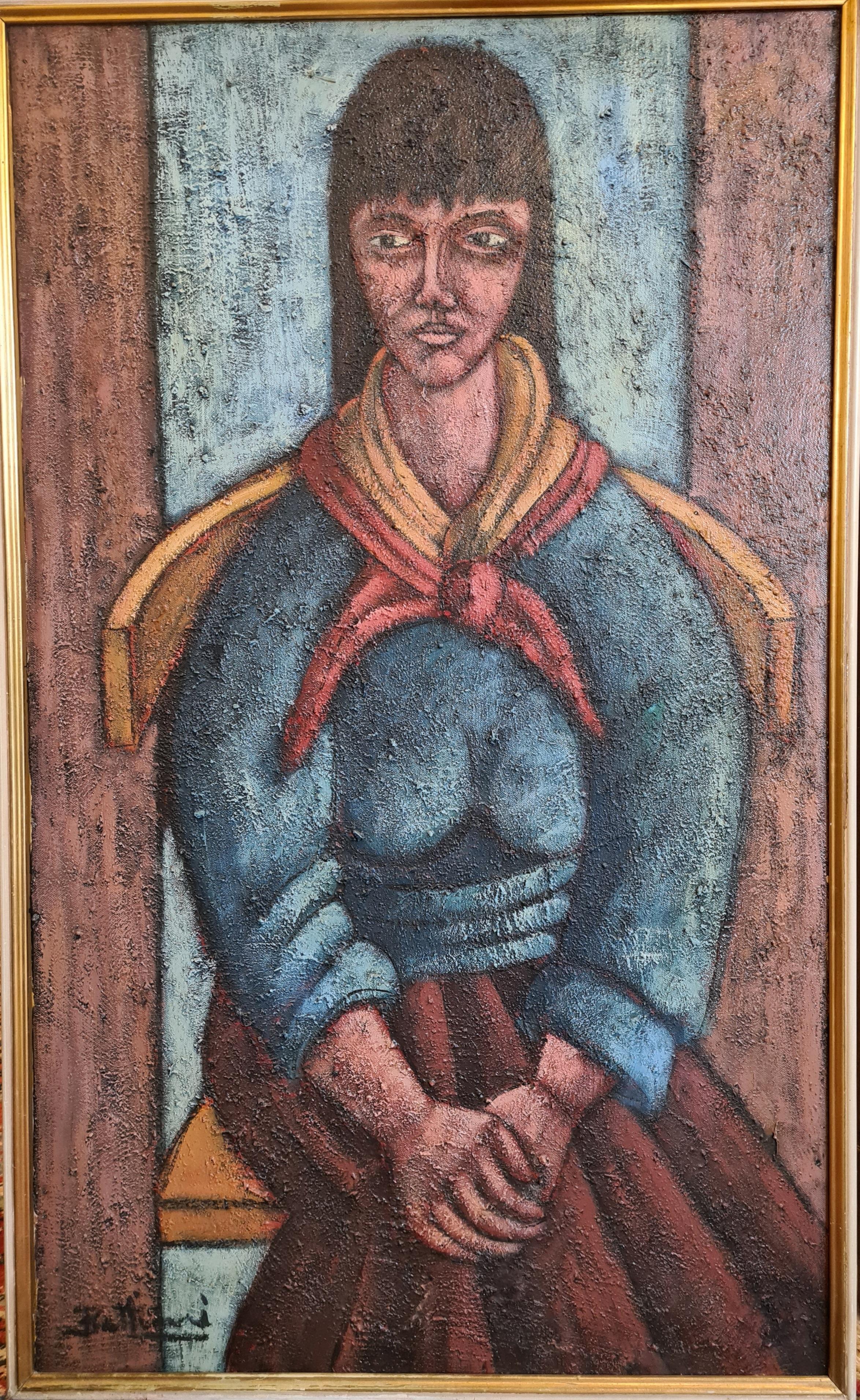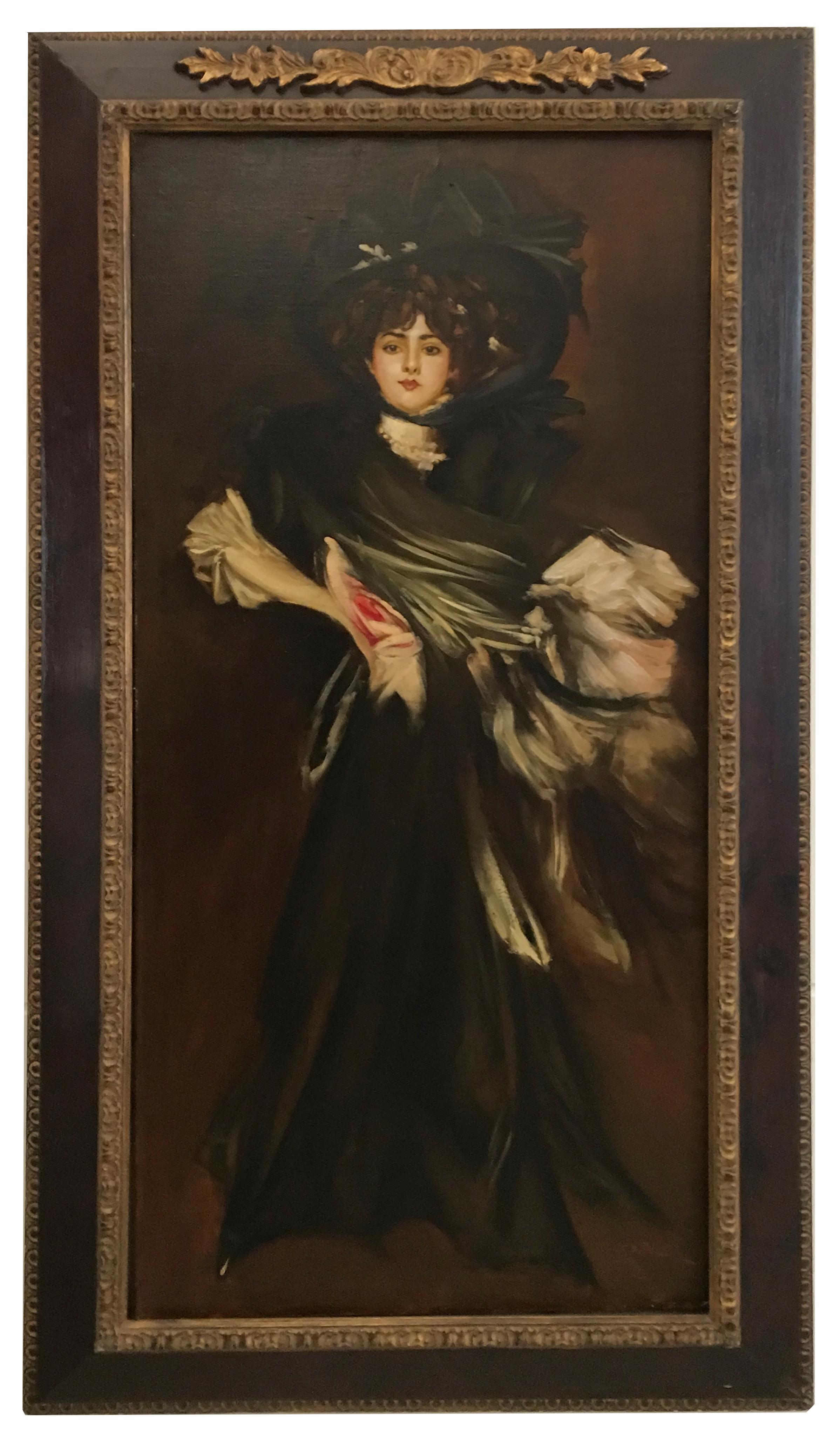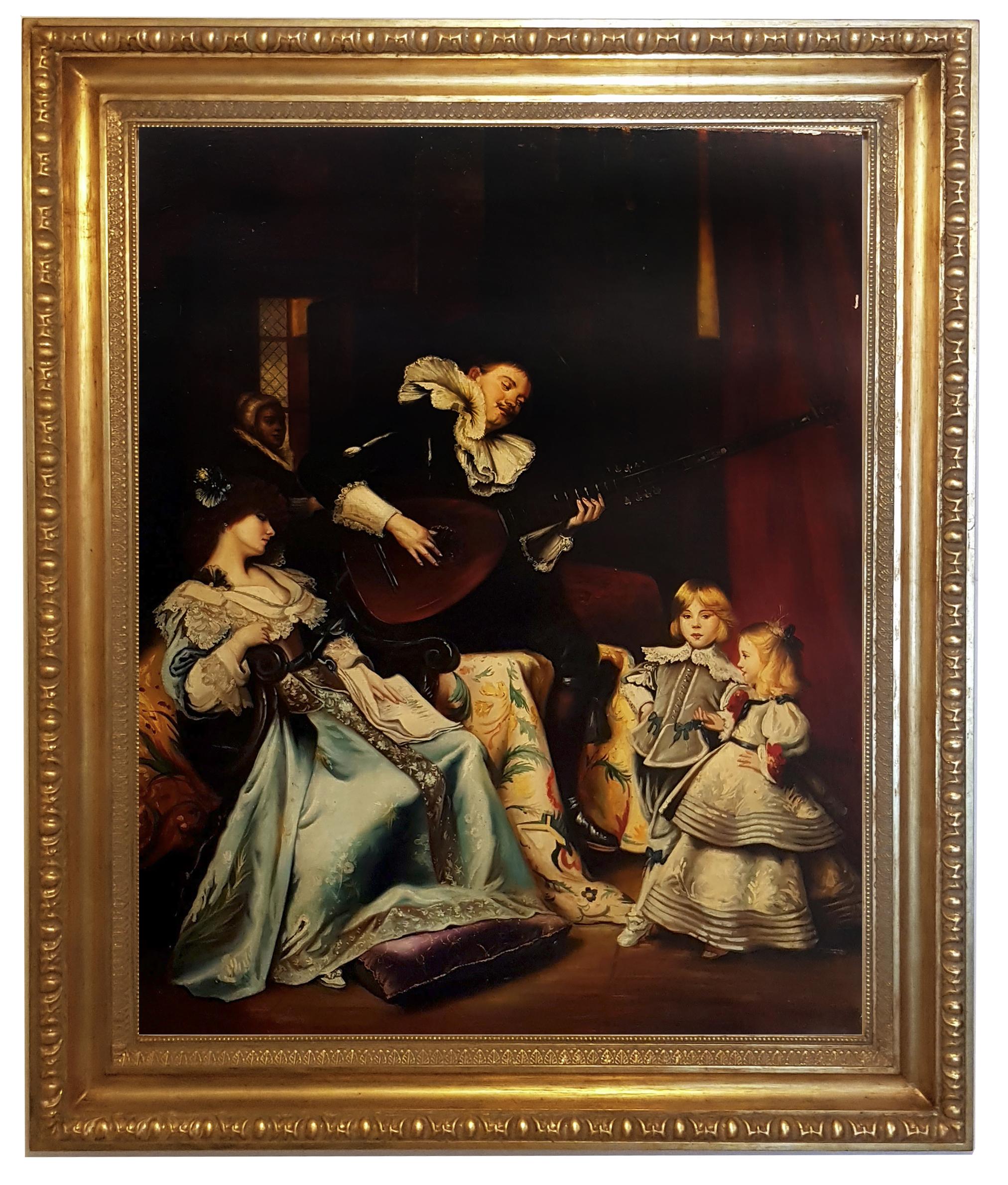Items Similar to Men portrait
Want more images or videos?
Request additional images or videos from the seller
1 of 11
Giovanni Maria delle Piane dit Mulinaretto (Genoa 1670 - Monticelli d´Ongina 1745)Men portraitcirca 1730
circa 1730
About the Item
Giovanni Maria DELLE PIANE, known as IL MULINARETTO
(Genoa, 1660 – Monticelli d'Ongina, 1745)
Portrait of a man
Oil on oval canvas
H. 108 cm; L. 83 cm
Provenance: Nino Ferrari Collection, Genoa, 1922
Exhibition: 1922, “Mostra della pittura italiana del Seicento et del Settecento”, Florence, Palazzo Pitti, n° 707 (Label on the frame)
The artist, better known as his nickname Mulinaretto, inherited from a miller grandfather, was born in Genoa in 1660. At the age of ten, he began attending the workshop of Giovan Battista Merano, where he completed his apprenticeship as a painter and where There he remained until 1676, when he moved to Rome, to improve under the direction of Giovan Battista Gaulli, il Baciccio. It was during this stay in Rome, which lasted about eight years, that the young man developed “the frank ability to translate with accuracy the most delicate and difficult physiognomies on the canvas” (Ratti 1769, p. 147). , thus demonstrating a remarkable aptitude for portraiture. Returning to Genoa in 1684, he was thus able to take advantage of his ability to paint humans, responding to the taste of the local clientele who recognized him as a gifted, sensitive artist, skilled in satisfying their needs for social recognition, according to a taste which was changing during this decade. The first works of the Mulinaretto, such as the portraits of the doge Pietro Durazzo (Genoa, National Gallery of Palazzo Spinola), of Gian Battista Cattaneo and his wife Maddalena Gentile with a daughter (Genoa, former collection of the Società Levante Assicurazioni) are included still in the style of Genoese portraiture from the first half of the 17th century, according to the methods of Gio Bernardo Carbone, a disciple of Van Dyck. It was probably towards the end of the century, during the last decade of the 17th century, that the artist renewed his style, adapting to the new fashion for French portraiture in the genre of Rigaud and Largillièrre. Works such as the portraits of the Doria House and the Durazzo House are characterized by a pleasant “worldliness” and a refined invention of backgrounds, sometimes even sumptuous. In 1695, il Mulinaretto, invited by Count Morando, made his first trip to Parma, a city in which he stayed several times, finding favor with the Farnese family: in 1706, the artist painted the portrait of Duke Francesco, of the Duchess Dorothée and Princess Elisabetta Farnese. After also making a few trips to Milan, Delle Piane moved to Parma in 1709, where he was appointed court painter. He returned to Genoa several times to respond to commissions, around 1714 and 1715, where he immortalized Elisabetta Farnese on the occasion of her marriage to Philip V of Spain; in this same period he lived in Piacenza, where he remained until 1737. It was probably in these years, around the middle of the second decade of the 18th century, that the artist found a more personal way, in which his various cultural references emerge, mixing its Italian and French inspirations. In 1719, il Mulinaretto declined the invitation to go to Spain, probably given by Elisabetta Farnese. Several years later, in 1737, he spent a stay in Naples, at the court of Charles Bourbon, son of Elisabetta. As a chamber painter, he depicted King Charles and his wife there. In 1741, the artist left Naples for Genoa, where he still painted the local nobility before retiring in 1744 to Monticelli d'Ongina near Piacenza, where he died the following year.
- Creator:Giovanni Maria delle Piane dit Mulinaretto (Genoa 1670 - Monticelli d´Ongina 1745) (1670 - 1745, Italian)
- Creation Year:circa 1730
- Dimensions:Height: 42.52 in (108 cm)Width: 32.68 in (83 cm)
- Medium:
- Movement & Style:
- Period:1730-1739
- Condition:Perfect condition. Cleaned.
- Gallery Location:BELEYMAS, FR
- Reference Number:1stDibs: LU1860214302302
About the Seller
No Reviews Yet
Vetted Seller
These experienced sellers undergo a comprehensive evaluation by our team of in-house experts.
Established in 2011
1stDibs seller since 2022
- ShippingRetrieving quote...Ships From: BELEYMAS, France
- Return PolicyThis item cannot be returned.
More From This SellerView All
- Attilio Manganaro (c.1865-c.1890) - Portrait of Gabriele d’Annunzio in 1887By Attilio ManganaroLocated in BELEYMAS, FRAttilio MANGANARO (c.1865 – c.1890) Portrait of Gabriele d'Annunzio in 1887 Oil on canvas H. 52 cm; L. 42 cm Signed and dated lower right 1887 On the...Category
1880s Italian School Figurative Paintings
MaterialsOil, Canvas
- French King Louis-Philippe - After Baron GérardLocated in BELEYMAS, FRAfter Baron Gérard, circa 1835 Portrait of King Louis-Philippe Oil on canvas H. 79 cm; L. 65 cm Provenance : Private collection, Périgord, by descent since the 19th century This po...Category
1830s French School Figurative Paintings
MaterialsCanvas, Oil
- François-Joseph Kinson - Young woman portrait with her dogBy Francois Kinsoen (Kinson)Located in BELEYMAS, FRFrançois-Joseph KINSON (Bruges 1770 – Bruges 1839) Portrait of a young woman near a spring, accompanied by her dog Oil on canvas H. 73 cm; L. 60 cm circa 1815-1817 We owe this elegant portrait to François-Joseph Kinson from Bruges, which is still linked to the art of the First Empire. We find in this artist this type of pose that is a bit rigid, sometimes with a countryside in the background, and this way of treating costumes and faces. Thus the full-length portrait of Jenny...Category
1810s French School Figurative Paintings
MaterialsCanvas, Oil
- French school c.1815 - Portrait of a young boyLocated in BELEYMAS, FRFrench school circa 1815 Portrait of a young boy Oil on canvas H. 84 cm; L. 70 cm Provenance: Señor Valdes Fauri Collection, Madrid around 1900/1950; then Private collection, Bordea...Category
1810s French School Figurative Paintings
MaterialsCanvas, Oil
- Young girl readingLocated in BELEYMAS, FRAlice BASTIDE (Saint Mandé 1868 – Paris 1959) Portrait of a little girl reading Oil on canvas H. 100 cm; L. 72.5 cm Signed lower right and dated 1912 Daughter of a pastor from Gard and an English woman, Alice Bastide grew up in Paris. A pupil of the Jullian Academy, she began her apprenticeship under the guidance of Henri Royer and François Schommer. The development of his art is mainly oriented towards still lifes, without completely abandoning portraits and landscapes. Her other specialty for which she received numerous awards is miniatures. At the Salon of 1914 she received the Maxime David prize crowning the best piece while her finesse was already noticed by press critics from 1907. Coronation, in 1926 she received a gold medal at the Salon for her miniature Coquetterie. In 1896, the young woman married a man from Gard, Auguste Massebiaux, whose name she would occasionally bear. The latter, a lawyer at the Paris Court of Appeal, died in 1910. The couple had no children. At that time she was domiciled at 48 avenue d'Orléans (later named avenue du general Leclerc) in Paris where she lived until her death in 1959. Until the mid-1930s she continued to exhibit at the Salon des Artistes French with a manner very close to Impressionism, luminous and vigorous. In 1912, two years after the death of her husband, Alice Bastide was certainly still marked by the sadness of her mourning. The tones of our portrait of a little girl and the frame she puts together are dark and heavy. This child, wearing an embroidered bonnet, is bent over her book, her loose hair flowing over a red velvet indoor dress. This intimate portrait on a dark tapestry...Category
1910s French School Figurative Paintings
MaterialsCanvas, Oil
- Sketch of a dandy portraitLocated in BELEYMAS, FRFrench school circa 1840 Sketch of a dandy portrait Oil on canvas mounted on cardboard H. 21 cm; L. 20.5 cmCategory
1830s French School Figurative Paintings
MaterialsCanvas, Oil
You May Also Like
- Woman Seated in a Klismos Chair. Italian School, Transavantgarde Oil on Canvas.Located in Cotignac, FRMid 20th Century Italian portrait of a seated lady signed Battionni bottom left. Presented in a white and gilt wood frame. A characterful stylised...Category
Mid-20th Century Italian School Figurative Paintings
MaterialsCanvas, Oil
- LADY'S PORTRAIT - Venetian School - Oil on Canvas Italian Figurative PaintingBy Giovanni SantanielloLocated in Napoli, ITLady's portrait - Giovanni Santaniello Italia 2002 - Oil on canvas cm. 100 x 80 The painting by Giovanni Santaniello depicts a portrait of a beautiful pensive woman in elegant clothe...Category
Early 2000s Italian School Portrait Paintings
MaterialsOil, Canvas
- LADY IN BLACK-In the Manner of G. Bodini Italy figurative oil on canvas paintingBy Eugenio De BlasiLocated in Napoli, ITLADY IN BLACK - Oil on canvas painting, Eugenio De Blasi, Italy, 2011 This is his reinterpretation of a greatest old master painting by Giovanni Boldini. Gold leaf gilded and mohogan...Category
Early 2000s Italian School Figurative Paintings
MaterialsOil, Canvas
- AUTUMN'S ALLEGORY - Eugenio De Blasi - Italian Portrait Italian Oil on CanvasBy Eugenio De BlasiLocated in Napoli, ITAutumn's Allegory - Oil on canvas cm.60x50, Italia, 2007, Eugenio De Blasi (3c59a) The painting by Eugenio De Blasi is an autumn allegory inspired by the allegorical figures of the ...Category
Early 2000s Italian School Portrait Paintings
MaterialsCanvas, Oil
- SCENE WITH MINSTREL- Eugenio De Blasi - Italy -Oil on canvas paintingBy Eugenio De BlasiLocated in Napoli, ITScene with Minstrel - Oil on canvas painting, Eugenio De Blasi, Italy, 2005 This is his reinterpretation of a greatest old master painting by Giovanni Boldini.Category
Early 2000s Italian School Figurative Paintings
MaterialsCanvas, Oil
- PORTRAIT OF YOUNG WOMAN - Venetian School -Italian oil on canvas paintingBy Eugenio De BlasiLocated in Napoli, ITPORTRAIT OF YOUNG WOMAN - Oil on canvas painting cm.95x65, Eugenio De Blasi, Italy, 2008 The painting by Eugenio De Blasi is inspired by the work of the Venetian painter and portrai...Category
Early 2000s Italian School Figurative Paintings
MaterialsCanvas, Oil





